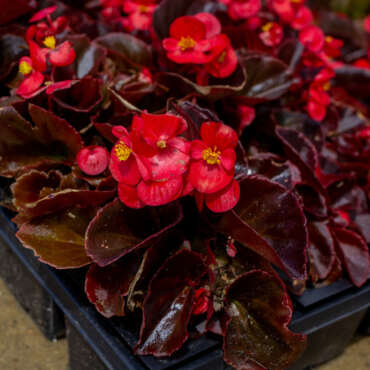Product Description
Begonias Red Leaf – Flats (36)
Typically used as houseplants and in shaded summer beds, begonias have tropical and subtropical origins. Some are grown for their asymmetrical, patterned and variegated foliage, and others to add color to shady garden areas with their bright blooms. Although typically on the smaller side, begonia plants pack a big punch of color and interest.
PLANTING
When to plant:
Transplant after all threat of frost has passed, as they are extremely frost tender and even temperatures below 50 degrees can cause damage.
Where to plant:
Select a location that gets partial shade or filtered sunlight; with morning sun and afternoon shade being the best, especially where it is exceptionally hot. For sunnier locations, try a dark-leaved variety or one that specifies improved sun tolerance, like Surefire® Rose. Plant in a location where they will have good air circulation to prevent powdery mildew.
How to plant:
Plant wax begonia transplants 6 to 8 inches apart and others according to their mature size. Tubers can be started indoors by placing the tubers, hollow side up, 1 inch apart in a shallow tray with moist potting mix. Place the tray in a dark room and water just enough to keep the potting mix moist, but not soggy. Tubers should sprout in about 4 weeks and be moved to an area with bright light once the sprouts are about an inch tall. Only plant outdoors when there is no longer a threat of frost.
BEGONIA CARE
Tuberous begonias will naturally die back each year. Start decreasing water in late summer to early fall and trim back foliage when it starts to yellow. Dig up the tubers at the first threat of frost. Clean any remaining dirt from the tubers and dry them on newspaper in a sunny location for about a week. To prevent powdery mildew, lightly dust them with sulfur powder and store individually in paper bags or wrapped in newspaper.
Rhizomatous and wax types don’t die back and are usually pinched or lightly pruned each year to keep them healthy and encourage full, but compact growth. In warmer climates, this is best done in spring. In cooler climates, you can do this in fall as a clean-up before bringing them inside for the winter. In addition to cutting them back, check for signs of pests or disease before moving them indoors. Slowly acclimate them to their new inside location by first placing in a bright window and gradually decreasing the amount of light. This will to help prevent stress, which causes the leaves to drop. Once warmer temperatures return, reverse the process and move them back outside. See below for information on growing as houseplants.
How to prune begonias:
- When cutting back rhizomatous or wax types, make a clean, angled cut just above a leaf or flower node, angling the cut away from the node as shown. To encourage fuller growth, younger plants (under 3 years) can be cut back to one or two nodes above the soil. Plants that are older should only be pruned lightly.
- For cane begonias, pinch the tops when plants are about 6 inches tall to encourage bushier growth. Cut any canes that are much taller than the rest of the plant back to the soil. Remove old, brown, bare, or dead canes to the soil. Younger plants can be cut back by about 1/2 with clean, angled cuts just above a node, angling the cut away from the node as shown.
- Rex begonias require little pruning. Pinch back young plants to encourage fuller growth, and remove any leggy or bare stems as needed, with angled cuts as shown.
- For all types, cut off spent begonia flowers about 1/2-inch below the flower to keep plants clean and healthy, as well as promote more blooms.
Information from www.gardendesign.com
Specifications
- Weight: 15 lb
- >>: Colors are approximate

